|
On Nov. 23, 1963, The Times reported that President Kennedy had been shot and killed by an assassin in Dallas, Texas.
|
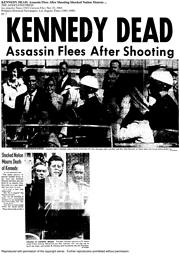
|
|
On Nov. 23 1963, The Times reported that Lee Harvey Oswald, 24, was questioned to see whether he had any connection with the assassination of President Kennedy.
|
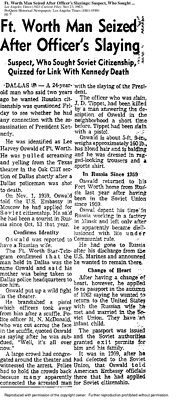
|
|
On Nov. 23, 1963, The Times reported that Lyndon B. Johnson was sworn in as President of the United States.
|
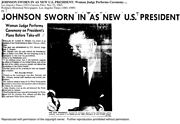
|
|
On Nov. 24, 1963, The Times reported that the assassination of President Kennedy was recorded in the files of the Dallas Police Department in the routine language of an ordinary homicide report.
|
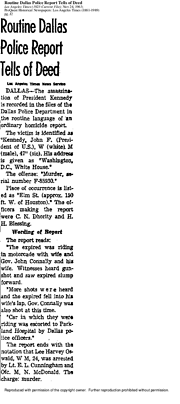
|
|
On Nov. 24, 1963, The Times reported that two important breakthroughs convinced authorities that Lee Harvey Oswald is the man who shot President Kennedy.
|

|
|
On Nov. 25, 1963, The Times reported that Lee Harvey Oswald’s palm print was found on the rifle which killed President Kennedy.
|

|
|
On Nov. 25, 1963 The Times reported that Lee Harvey Oswald was shot and killed as he was being transferred from the Dallas city jail to the county jail.
|
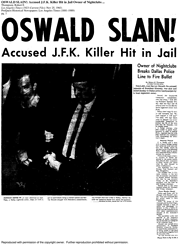
|
|
On Nov. 25, 1963, The Times reported Gene Blake’s eyewitness account of the shooting of Lee Harvey Oswald.
|

|
|
On Nov. 25, 1963 The Time reported that Lee Harvey Oswald had lived in obscurity until his arrest for the murder of the President.
|
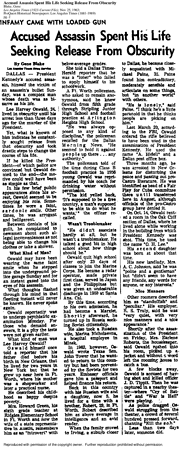
|
|
On Nov. 26, 1963, The Times reported that President John F. Kennedy was buried with full military honors at Arlington National Cemetery.
|

|
|
On Nov. 26, 1963, The Times reported that Lee Harvey Oswald was buried in Arlington, Texas, shortly after President Kennedy was laid to rest in Arlington National Cemetery.
|

|
|
On Nov. 26, 1963, The Times reported that Jack Ruby, accused of killing Lee Harvey Oswald, was moved from the Dallas police headquarters to the county jail.
|

|
|
On Nov. 27, 1963, The Times reported that two investigations into the assassination of President Kennedy were underway and a third scheduled.
|
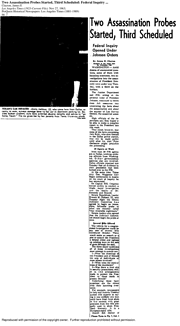
|
|
On Nov. 28, 1963, The Times reported that Gov. John Connally, wounded during the assassination of President Kennedy, gave his first interview.
|

|
|
On Nov. 30, 1963, The Times reported on the final moments in Dallas’ Parkland Hospital.
|
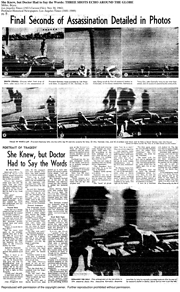
|
|
On Dec. 1, 1963, The Times reported that President Johnson’s special commission, lead by Chief Justice Earl Warren, had begun their investigation of the Kennedy assassination.
|
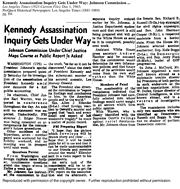
|
|
On Dec. 4, 1963, The Times reported that an FBI report on the assassination of President Kennedy concludes that there was no conspiracy between Lee Harvey Oswald and Jack Ruby.
|
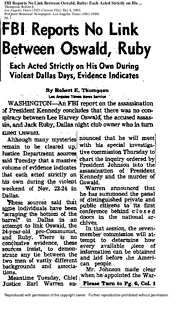
|
|
On Mar. 4, 1964, The Times reported on the 12 jurors chosen to hear the Jack Ruby murder trial.
|

|
|
On Mar. 14, 1964, The Times reported that the murder case against Jack Ruby had gone to the jury of eight men and four women.
|
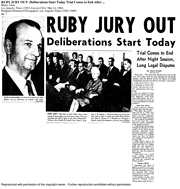
|
|
On Mar. 15, 1964, The Times reported that Jack Ruby was convicted of murder for the slaying of accused Presidential assassin Lee Harvey Oswald.
|
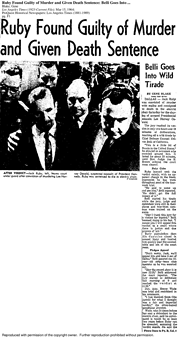
|
|
On June 8, 1964, The Times reported that Chief Justice Earl Warren spent more than 3 hours with Jack Ruby in the Dallas County Jail.
|

|
|
On Sept. 28, 1964, The Times reported that the Warren Commission had ruled that Lee Harvey Oswald acted alone when he assassinated President Kennedy.
|
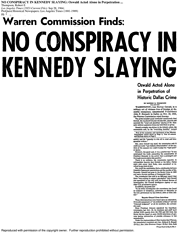
|
|
On Sept. 28, 1964, The Times published the text of the summary and conclusions in the Warren Commission report.
|
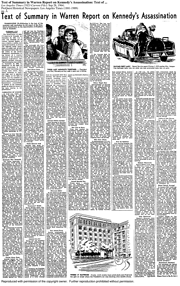
|
|
On Oct. 6, 1966, The Times reported that the Texas Court of Criminal Appeals had reversed the conviction and death sentence of Jack Ruby.
|
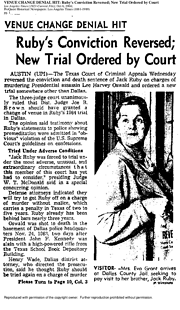
|
|
On Jan. 3, 1967, The Times reported that Jack Ruby had secretly taped a denial of any conspiracy in the slaying of Lee Harvey Oswald.
|
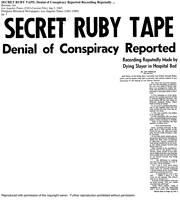
|
|
On Jan. 4, 1967, The Times reported that Jack Ruby had died at the same hospital where President John F. Kennedy and Lee Harvey Oswald had died.
|
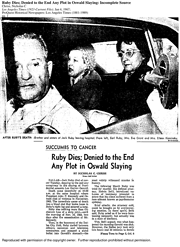
|
|
On Jan. 4, 1967, The Times wrote about, Jack Ruby, the tough kid from Chicago.
|
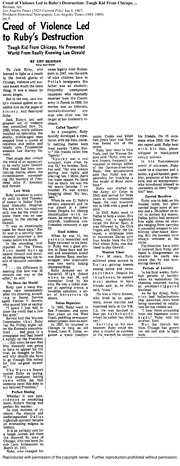
|































